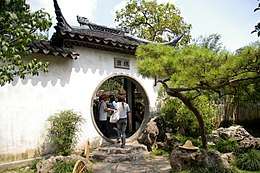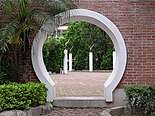Moon gate
A moon gate (Chinese: 月亮门; pinyin: yuèliàngmén) is a circular opening in a garden wall that acts as a pedestrian passageway and is a traditional architectural element in Chinese gardens. Moon Gates have many different spiritual meanings for every piece of tile on the gate and on the shape of it. The sloping roofs of the gate represent the half moon of the Chinese Summers and the tips of the tiles of the roof have talismans on the ends of them. Chinese Gardens are often used as a display of class and beauty in many different Western cultures. The purpose of these gates is to serve as a very inviting entrance into gardens of the rich upper class in China. The gates were originally only found in the gardens of wealthy Chinese nobles.

Moon gates were incorporated into the architecture of Bermuda in the late 19th century, around the same time that the British territory began importing Easter lily bulbs from Japan for cultivation. The Bermuda Moon Gate is slightly different from the original Chinese design, as it is often left free-standing or attached to low wall. In Bermuda, it is regarded as good luck for newlyweds to step through the gate.
Gallery
 Moon gate at Couple's Retreat Garden in the Classical Gardens of Suzhou
Moon gate at Couple's Retreat Garden in the Classical Gardens of Suzhou- Lai Chi Kok Park Chinese Arch
- Tong Study Hall MoonGate
 Zhonghe park
Zhonghe park- A Moon Gate in Bermuda
 Moon Gate, National Bonsai and Penjing Museum, National Arboretum, Washington DC
Moon Gate, National Bonsai and Penjing Museum, National Arboretum, Washington DC- Entrance to the Astor Court, a Ming-style garden at the Metropolitan Museum of Art
- Moon gate in Great Wave Pavilion
| Wikimedia Commons has media related to Moon gates. |